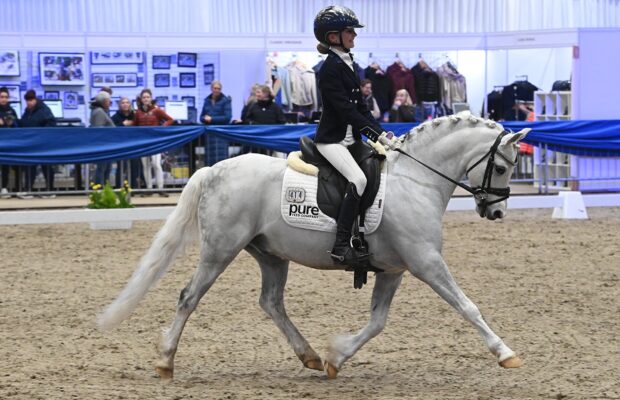Dressage Olympian Richard Davison highlights his pressure and release techniques, which he uses daily in his training
{"content":"PHA+SG93IG1hbnkgdGltZXMgaGF2ZSB5b3UgcHV0IG9uIGEgcGFpciBvZiB0aWdodHMgb3IgYSBwYWlyIG9mIGdsYXNzZXMgb25seSBmb3IgdGhlbSB0byBmZWVsIOKAmGZvcmVpZ27igJkgeWV0IGhvdXJzIOKAlCBvciBzb21ldGltZXMgbWludXRlcyDigJQgbGF0ZXIgeW91IGNhbuKAmXQgZXZlbiBmZWVsIHRoZW0\/PC9wPgo8cD5EZXNlbnNpdGlzYXRpb24gZ29lcyBvbiBhbGwgdGhlIHRpbWUsIGJ1dCBpcyB0aGVyZSBhIHdheSBvZiBpbmNyZWFzaW5nIHRoZSBzZW5zaXRpdml0eSB0byBhIHBhcnRpY3VsYXIgc3RpbXVsdXMsIG5hbWVseSB0aGUgcmlkZXIgdXNpbmcgdGhlaXIgbGVnIG9uIHRoZSBob3JzZeKAmXMgc2lkZSwgb3IgdGhlaXIgcmVpbj88L3A+CjxwPjxkaXYgY2xhc3M9ImFkLWNvbnRhaW5lciBhZC1jb250YWluZXItLW1vYmlsZSI+PGRpdiBpZD0icG9zdC1pbmxpbmUtMSIgY2xhc3M9ImlwYy1hZHZlcnQiPjwvZGl2PjwvZGl2PjxkaXYgaWQ9InRhYm9vbGEtbWlkLWFydGljbGUiPjwvZGl2PjxzY3JpcHQ+d2luZG93Ll90YWJvb2xhU2xvdHM9d2luZG93Ll90YWJvb2xhU2xvdHN8fFtdO3dpbmRvdy5fdGFib29sYVNsb3RzLnB1c2goeyJtb2RlIjoidGh1bWJuYWlscy1hLW1pZCIsImNvbnRhaW5lciI6InRhYm9vbGEtbWlkLWFydGljbGUiLCJwbGFjZW1lbnQiOiJNaWQgQXJ0aWNsZSIsInRhcmdldF90eXBlIjoibWl4In0pOzwvc2NyaXB0PjxzZWN0aW9uIGlkPSJlbWJlZF9jb2RlLTM2IiBjbGFzcz0iIHMtY29udGFpbmVyIHN0aWNreS1hbmNob3IgaGlkZS13aWRnZXQtdGl0bGUgd2lkZ2V0X2VtYmVkX2NvZGUgcHJlbWl1bV9pbmxpbmVfMSI+PGRpdiBzdHlsZT0icGFkZGluZzogMHB4ICFpbXBvcnRhbnQ7Ij48ZGl2IGlkPSJwaWFuby1wYXl3YWxsLW1ldGVyLWJhcnJpZXIiIHN0eWxlPSJ0ZXh0LWFsaWduOiBjZW50ZXI7IHZlcnRpY2FsLWFsaWduOiBtaWRkbGU7Ij48L2Rpdj48L2Rpdj4NCg0KPHN0eWxlPg0KI3BpYW5vLXBheXdhbGwtbWV0ZXItYmFycmllciAudHAtY29udGFpbmVyLWlubmVyIHsNCiAgICBwb3NpdGlvbjogYWJzb2x1dGU7DQogICAgaGVpZ2h0OiA5OTk5OXB4ICFpbXBvcnRhbnQ7DQogICAgYmFja2dyb3VuZDogbGluZWFyLWdyYWRpZW50KDE4MGRlZywgdHJhbnNwYXJlbnQgNjAwcHgsIHdoaXRlIDg1MHB4KTsNCn0NCjwvc3R5bGU+PC9zZWN0aW9uPjxzZWN0aW9uIGlkPSJrZXlzdG9uZS12b2VwLXdpZGdldC0zIiBjbGFzcz0iIHMtY29udGFpbmVyIHN0aWNreS1hbmNob3Iga2V5c3RvbmUtdm9lcC13aWRnZXQgcHJlbWl1bV9pbmxpbmVfMSI+CjxkaXYgY2xhc3M9Imp3cGxheWVyLWNvbnRhaW5lciBqd3BsYXllci1tYXJnaW4tYm90dG9tIj4KPGRpdiBjbGFzcz0iandwbGF5ZXItd3JhcHBlciI+CjxkaXYgY2xhc3M9Imp3cGxheWVyLW1pbmltaXplLWNsb3NlIj4KCQkJCTxzdmcgeG1sbnM9Imh0dHA6Ly93d3cudzMub3JnLzIwMDAvc3ZnIiBjbGFzcz0ianctc3ZnLWljb24ganctc3ZnLWljb24tY2xvc2UiIHZpZXdCb3g9IjAgMCAyNDAgMjQwIiBmb2N1c2FibGU9ImZhbHNlIj4KCQkJCQk8cGF0aCBkPSJNMTM0LjgsMTIwbDQ4LjYtNDguNmMyLTEuOSwyLjEtNS4yLDAuMi03LjJjMCwwLTAuMS0wLjEtMC4yLTAuMmwtNy40LTcuNGMtMS45LTItNS4yLTIuMS03LjItMC4yYzAsMC0wLjEsMC4xLTAuMiwwLjJMMTIwLDEwNS4yTDcxLjQsNTYuNmMtMS45LTItNS4yLTIuMS03LjItMC4yYzAsMC0wLjEsMC4xLTAuMiwwLjJMNTYuNiw2NGMtMiwxLjktMi4xLDUuMi0wLjIsNy4yYzAsMCwwLjEsMC4xLDAuMiwwLjJsNDguNiw0OC43bC00OC42LDQ4LjZjLTIsMS45LTIuMSw1LjItMC4yLDcuMmMwLDAsMC4xLDAuMSwwLjIsMC4ybDcuNCw3LjRjMS45LDIsNS4yLDIuMSw3LjIsMC4yYzAsMCwwLjEtMC4xLDAuMi0wLjJsNDguNy00OC42bDQ4LjYsNDguNmMxLjksMiw1LjIsMi4xLDcuMiwwLjJjMCwwLDAuMS0wLjEsMC4yLTAuMmw3LjQtNy40YzItMS45LDIuMS01LjIsMC4yLTcuMmMwLDAtMC4xLTAuMS0wLjItMC4yTDEzNC44LDEyMHoiPjwvcGF0aD4KCQkJCTwvc3ZnPgoJCQk8L2Rpdj4KPGRpdgoJCQkJZGF0YS1wbGF5ZXI9IktNVWNuUmlJIgoJCQkJZGF0YS1rZXk9InNBT1B2emwzIgoJCQkJZGF0YS1sb2FkZWQ9ImZhbHNlIgoJCQkJY2xhc3M9Imp3cGxheWVyIgoJCQkJaWQ9Imp3cGxheWVyX3NBT1B2emwzX0tNVWNuUmlJXzI1X2RpdiI+CgkJCTwvZGl2Pgo8L3A+PC9kaXY+CjwvcD48L2Rpdj4KPC9zZWN0aW9uPjwvcD4KPGgzPkxhenkgaG9yc2UgdHJhaW5pbmcgdGlwczwvaDM+CjxwPlRvIHRyYWluIGEgbGF6eSBob3JzZSwgUmljaGFyZCBhZHZpc2VzIHN0YXJ0aW5nIHdpdGggdGhlIGJhc2ljcy48L3A+CjxwPkZyb20gaGFsdCwgZ2l2ZSB0aGUgaG9yc2UgYSBzbWFsbCBhaWQgd2l0aCBib3RoIGxlZ3MuIFdhaXQgZm9yIGEgc2Vjb25kICh0aGUgc2Vjb25k4oCZcyBnYXAgaXMgY3J1Y2lhbCkuIElmIHRoZSBob3JzZSBkb2VzIG5vdCByZWFjdCBieSBzdGVwcGluZyBmb3J3YXJkIHNtYXJ0bHksIHRoZW4gZ2l2ZSBhIHNlY29uZCwgbGFyZ2VyIGFpZC4gV2hlbiB0aGUgaG9yc2UgcmVhY3RzIHRvIHRoaXMgc2hhcnBlciBhaWQsIHBhdCBoaW0gYW5kIGFsbG93IGhpbSB0byBnbyBmb3J3YXJkcy4gQWZ0ZXIgYSBnb29kIGZldyBzdHJpZGVzLCBicmluZyB0aGUgaG9yc2UgYmFjayB0byBoYWx0IGFuZCB1c2UgdGhlIHNtYWxsIGFpZCB0byBhc2sgaGltIHRvIHdhbGsgb24gYWdhaW4uPC9wPgo8cD5XaXRoaW4gYSBzaG9ydCBzcGFjZSBvZiB0aW1lLCB0aGUgaG9yc2Ugd2lsbCBsZWFybiB0byBtb3ZlIGZyZWVseSBmb3J3YXJkcyBmcm9tIHRoZSBvcmlnaW5hbCwgc21hbGwgYWlkLjwvcD4KPHA+PGRpdiBjbGFzcz0iYWQtY29udGFpbmVyIGFkLWNvbnRhaW5lci0tbW9iaWxlIj48ZGl2IGlkPSJwb3N0LWlubGluZS0yIiBjbGFzcz0iaXBjLWFkdmVydCI+PC9kaXY+PC9kaXY+PHNlY3Rpb24gaWQ9ImVtYmVkX2NvZGUtMzEiIGNsYXNzPSJoaWRkZW4tbWQgaGlkZGVuLWxnIHMtY29udGFpbmVyIHN0aWNreS1hbmNob3IgaGlkZS13aWRnZXQtdGl0bGUgd2lkZ2V0X2VtYmVkX2NvZGUgcHJlbWl1bV9pbmxpbmVfMiI+PHNlY3Rpb24gY2xhc3M9InMtY29udGFpbmVyIGxpc3RpbmctLXNpbmdsZSBsaXN0aW5nLS1zaW5nbGUtc2hhcmV0aHJvdWdoIGltYWdlLWFzcGVjdC1sYW5kc2NhcGUgZGVmYXVsdCBzaGFyZXRocm91Z2gtYWQgc2hhcmV0aHJvdWdoLWFkLWhpZGRlbiI+DQogIDxkaXYgY2xhc3M9InMtY29udGFpbmVyX19pbm5lciI+DQogICAgPHVsPg0KICAgICAgPGxpIGlkPSJuYXRpdmUtY29udGVudC1tb2JpbGUiIGNsYXNzPSJsaXN0aW5nLWl0ZW0iPg0KICAgICAgPC9saT4NCiAgICA8L3VsPg0KICA8L2Rpdj4NCjwvc2VjdGlvbj48L3NlY3Rpb24+PC9wPgo8cD5PbmNlIHRoZSBob3JzZSBoYXMgYmVjb21lIG1vcmUgcmVhY3RpdmUgdG8gdGhlIHNtYWxsIHdhbGsgYWlkLCByaWRlIHRoZSBzYW1lIGV4ZXJjaXNlIGJldHdlZW4gd2FsayBhbmQgdHJvdCwgdGhlbiB3YWxrIGFuZCBjYW50ZXIuPC9wPgo8cD5UbyBmdXJ0aGVyIHJlZmluZSB0aGUgdXNlIG9mIHRoZSBsZWcsIHRoZSByaWRlciBjYW4gYWxzbyBsZWFuIGZvcndhcmRzIChpbiBhbiBleGFnZ2VyYXRlZCB3YXkgYXQgZmlyc3QsIGJ1dCBldmVudHVhbGx5IHNvIHN1YnRseSBzbyBhcyB0byBiZSBpbXBlcmNlcHRpYmxlIGZyb20gdGhlIGdyb3VuZC4gVGhpcyBicm9hZGVucyB0aGUgcmlkZXLigJlzIGFyc2VuYWwgYW5kIGdpdmVzIHRoZW0gYW5vdGhlciB3YXkgb2YgYXNraW5nIHRoZSBob3JzZSB0byBnbyBmb3J3YXJkIG90aGVyIHRoYW4gdGhlIGxlZy48L3A+CjxkaXYgY2xhc3M9ImluamVjdGlvbiI+PC9kaXY+CjxwPlRvIGluY3JlYXNlIHNlbnNpdGl2aXR5IHRvIHRoZSByZWluIGFpZCwgdXNlIGEgc2ltaWxhciBleGVyY2lzZTogdG8gYnJpbmcgdGhlIGhvcnNlIGJhY2sgKGZyb20gd2FsayB0byBoYWx0LCBmb3IgZXhhbXBsZSksIHVzZSBhIHNtYWxsIGFpZCBkb3duIHRoZSByZWluLiBJZiBoZSBkb2VzbuKAmXQgcmVzcG9uZCBhcHByb3ByaWF0ZWx5IOKAlCBub3QgZm9yZ2V0dGluZyBhbGxvd2luZyB0aGF0IHNlY29uZCBmb3IgdGhlIGhvcnNlIHRvIHJlYWN0IOKAlCB0aGVuIGdpdmUgYSBsYXJnZXIsIHN0cm9uZ2VyIGFpZCB3aXRoIHRoZSByZWluLiBBZ2FpbiB1c2Ugb2YgdGhlIHVwcGVyIGJvZHkgY2FuIGhlbHAgaGVyZS4gTGVhbiBiYWNrIHNsaWdodGx5IHRvIHRlYWNoIHRoZSBob3JzZSB0aGF0IG1vdmluZyB5b3VyIHdlaWdodCBiYWNrd2FyZHMgaXMgYXNraW5nIGhpbSB0byBjb21lIGJhY2sgdG8geW91IG9yIHNsb3cgZG93biDigJQgdGhpcyBtZWFucyB0aGF0LCBvbmNlIHJlZmluZWQsIHRoZSBob3JzZSBzaG91bGQgcmVzcG9uZCB0byBhIHN1YnRsZSBzaGlmdCBpbiB0aGUgcmlkZXLigJlzIHdlaWdodCwgZnJlZWluZyB1cCB0aGUgcmVpbnMgdG8gZG8gdGhlIGZpbmUgdHVuaW5nIG9uIGJlbmQgYW5kIHN0ZWVyaW5nLjwvcD4KPGRpdiBjbGFzcz0iYWQtY29udGFpbmVyIGFkLWNvbnRhaW5lci0tbW9iaWxlIj48ZGl2IGlkPSJwb3N0LWlubGluZS0zIiBjbGFzcz0iaXBjLWFkdmVydCI+PC9kaXY+PC9kaXY+CjxwPkJvdGggdGhlc2UgZXhlcmNpc2VzIHVsdGltYXRlbHkgbWVhbiB0aGF0IHRoZSByaWRlciBzaG91bGQgaGF2ZSB0byBkbyBsZXNzIGluIHRoZSBzYWRkbGUgYW5kIGJlIGFibGUgdG8gc2l0IG1vcmUgcXVpZXRseSB3aGlsZSBleGVydGluZyBhIG1vcmUgc3VidGxlIHlldCBlZmZlY3RpdmUgY29udHJvbCBvZiB0aGUgaG9yc2UuPC9wPgo8cD4K"}
This site is protected by reCAPTCHA and the Google Privacy Policy and Terms of Service apply.




